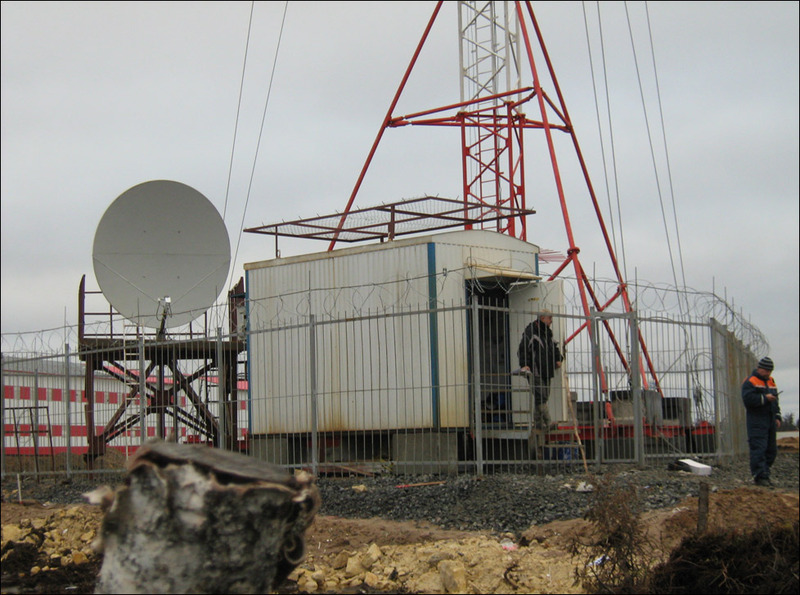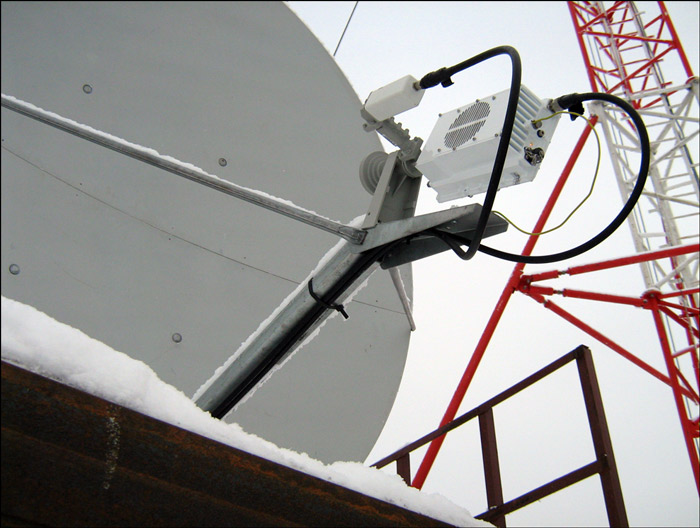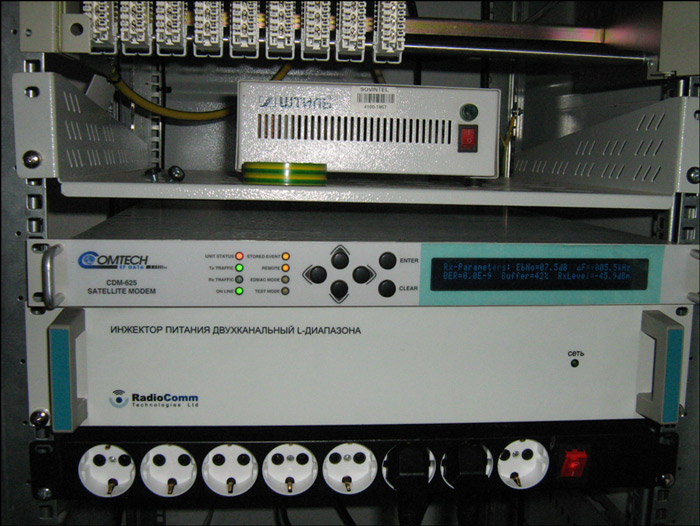How we made the connection at the Grib diamond deposit
To the northeast of Arkhangelsk there is the Grib diamond deposit , which employs several thousand people. There are no settlements as such in the area, only temporary houses with workers. And just these people need a connection in order to be able to talk to their relatives or just go online for e-mail.
To accommodate the base station it took the construction of such a tower. There are cellular antennas and some equipment on it:

42-meter tower
')
Construction of the mast is the most expensive and long stage of construction of the base station. Such a high mast - 42 meters - was needed in order to provide with communication a rather large territory. The area is large, plus the complex relief of the field itself. Coverage area of 8-12 km. There are no closest neighbors. Our nearest base station is located at a distance of more than 150 kilometers. The communication channel with the “large network” is satellite, the base station itself is of a distributed type.
It was difficult to build a tower not because of the winds, as you might think, but because of a bit of unusual logistics (the sections needed to be delivered to the area without normal roads), plus heaps of trouble with security — the object was closed, it was necessary to build and launch the base station. blindly. Before us there was no connection.
After the construction of the mast, a ZSSS terminal (satellite earth station, satellite dish, satellite receiver, transmitter) and a container in which the equipment was placed was installed. The container is sealed, air conditioners and heating systems are installed, everything works in automatic mode.
The radiation power of the satellite transmitter is 4 W; therefore, it is impossible to be in the antenna's range when the transmitter is on, you can easily walk behind the antenna. The photo is not entirely obvious, but the container is in a safe area.

Satellite dish and equipment container
All consumers are connected to the high-voltage line, then a transformer substation is installed. In the container batteries are installed, in case of loss of electricity. The base station is able to work on them for another 5 hours, in the case of a long-term lack of electricity - we bring diesel generator sets and fuel.
The SCSS is required for a base station to communicate with a BS controller located in Arkhangelsk and then with a switch. On the satellite channel, the E1 channel was raised at a speed of 2048 kb / s. One voice channel with Half Rate encoding takes 8 kb / s, so there is still room for mobile Internet traffic in the channel. The possibility of rebuilding the dish to another satellite is, done by hand. The plate is well fixed and calibration is usually not required. In practice, if everything is set up correctly, then for at least five years it is possible not to touch anything, even with strong winds, it is only important to clean the snow.

Directly at the antenna SSSS mounted transmitter (large unit) and LNA-low-noise amplifier of the receiving path (small). The photo shows the holes in the case - we close them on this object with plugs so that the snow does not get inside.

A satellite modem Comtech, an injector for powering the satellite transceiver, was installed in the container. The container temperature is maintained at about 23 degrees due to two air conditioners.
On the mast and container also installed the base station equipment Nokia Flexi EDGE.
This type of base station is distributed, i.e. control unit and transmitters are spaced apart. Now this scheme is used at all new base stations to save electricity in the framework of the "green" project , but specifically at our site it is also a necessity due to rather difficult weather conditions.
The control unit of the ESMB base station (installed in the container) is responsible for controlling the transmitters, storing and distributing the software, lifting the ABIS interface, via a satellite communication channel to the base station controller.

The ESMA connects to the EXEA transmitters over a high-speed data bus via an optical cable. EXEA are installed directly at the antennas, thus avoiding losses in the feeder path.

EXEA with open case cover.
Initially, one unit was delivered, it supports a configuration with three sectors of two frequencies in each sector with a power of radiated frequency of 30 watts. The maximum number of simultaneously talking subscribers with this configuration is 84, which was not enough in the first month after the launch of the BS.
Now on the BS added another block EXDA, which allows the BS to cope with traffic without overloads. The radiated power of the most loaded sector was reduced, which made it possible to increase the number of frequencies to 6 in this sector. Total BS emits at 10 frequencies, which allows you to organize up to 148 conversational channels. Traffic per week more than 3,300 erlang. The load is constantly large, the decline happens only at night. Due to the heavy network load and voice priority, the download speed is low, an average of 20-60 Kbps, but in theory the maximum speed is 384 Kbps, but this is only in theory, using the EDGE data transmission standard (EGPRS).
People live on-site on a rotational basis on average for a month, everyone works at the field. Most often they call relatives, use mail and rather actively - social networks via mobile access, despite almost a second ping because of the satellite channel.
At the field, at the moment, preparations are underway for the extraction of diamonds - a pit has been dug, groundwater is being diverted, a plant is being built to process the mined rock, mining itself will start at least two years later, and there will be enough reserves, at least 15 years from the local workers.
That's all. If you have questions about the installation and hardware - ask. More details are in the past topic about satellite terminals and snow from my colleague.
To accommodate the base station it took the construction of such a tower. There are cellular antennas and some equipment on it:

42-meter tower
')
Construction of the mast is the most expensive and long stage of construction of the base station. Such a high mast - 42 meters - was needed in order to provide with communication a rather large territory. The area is large, plus the complex relief of the field itself. Coverage area of 8-12 km. There are no closest neighbors. Our nearest base station is located at a distance of more than 150 kilometers. The communication channel with the “large network” is satellite, the base station itself is of a distributed type.
It was difficult to build a tower not because of the winds, as you might think, but because of a bit of unusual logistics (the sections needed to be delivered to the area without normal roads), plus heaps of trouble with security — the object was closed, it was necessary to build and launch the base station. blindly. Before us there was no connection.
After the construction of the mast, a ZSSS terminal (satellite earth station, satellite dish, satellite receiver, transmitter) and a container in which the equipment was placed was installed. The container is sealed, air conditioners and heating systems are installed, everything works in automatic mode.
The radiation power of the satellite transmitter is 4 W; therefore, it is impossible to be in the antenna's range when the transmitter is on, you can easily walk behind the antenna. The photo is not entirely obvious, but the container is in a safe area.

Satellite dish and equipment container
All consumers are connected to the high-voltage line, then a transformer substation is installed. In the container batteries are installed, in case of loss of electricity. The base station is able to work on them for another 5 hours, in the case of a long-term lack of electricity - we bring diesel generator sets and fuel.
The SCSS is required for a base station to communicate with a BS controller located in Arkhangelsk and then with a switch. On the satellite channel, the E1 channel was raised at a speed of 2048 kb / s. One voice channel with Half Rate encoding takes 8 kb / s, so there is still room for mobile Internet traffic in the channel. The possibility of rebuilding the dish to another satellite is, done by hand. The plate is well fixed and calibration is usually not required. In practice, if everything is set up correctly, then for at least five years it is possible not to touch anything, even with strong winds, it is only important to clean the snow.

Directly at the antenna SSSS mounted transmitter (large unit) and LNA-low-noise amplifier of the receiving path (small). The photo shows the holes in the case - we close them on this object with plugs so that the snow does not get inside.

A satellite modem Comtech, an injector for powering the satellite transceiver, was installed in the container. The container temperature is maintained at about 23 degrees due to two air conditioners.
On the mast and container also installed the base station equipment Nokia Flexi EDGE.
This type of base station is distributed, i.e. control unit and transmitters are spaced apart. Now this scheme is used at all new base stations to save electricity in the framework of the "green" project , but specifically at our site it is also a necessity due to rather difficult weather conditions.
The control unit of the ESMB base station (installed in the container) is responsible for controlling the transmitters, storing and distributing the software, lifting the ABIS interface, via a satellite communication channel to the base station controller.

The ESMA connects to the EXEA transmitters over a high-speed data bus via an optical cable. EXEA are installed directly at the antennas, thus avoiding losses in the feeder path.

EXEA with open case cover.
Initially, one unit was delivered, it supports a configuration with three sectors of two frequencies in each sector with a power of radiated frequency of 30 watts. The maximum number of simultaneously talking subscribers with this configuration is 84, which was not enough in the first month after the launch of the BS.
Now on the BS added another block EXDA, which allows the BS to cope with traffic without overloads. The radiated power of the most loaded sector was reduced, which made it possible to increase the number of frequencies to 6 in this sector. Total BS emits at 10 frequencies, which allows you to organize up to 148 conversational channels. Traffic per week more than 3,300 erlang. The load is constantly large, the decline happens only at night. Due to the heavy network load and voice priority, the download speed is low, an average of 20-60 Kbps, but in theory the maximum speed is 384 Kbps, but this is only in theory, using the EDGE data transmission standard (EGPRS).
People live on-site on a rotational basis on average for a month, everyone works at the field. Most often they call relatives, use mail and rather actively - social networks via mobile access, despite almost a second ping because of the satellite channel.
At the field, at the moment, preparations are underway for the extraction of diamonds - a pit has been dug, groundwater is being diverted, a plant is being built to process the mined rock, mining itself will start at least two years later, and there will be enough reserves, at least 15 years from the local workers.
That's all. If you have questions about the installation and hardware - ask. More details are in the past topic about satellite terminals and snow from my colleague.
Source: https://habr.com/ru/post/178325/
All Articles